C++面向对象程序设计-北京大学-郭炜【课程笔记(九)】
开始课程:P33 1_1. 输入输出流相关的类
课程链接:程序设计与算法(三)C++面向对象程序设计 北京大学 郭炜
课程PPT:github提供的对应课程PPT
1、输入输出流相关的类
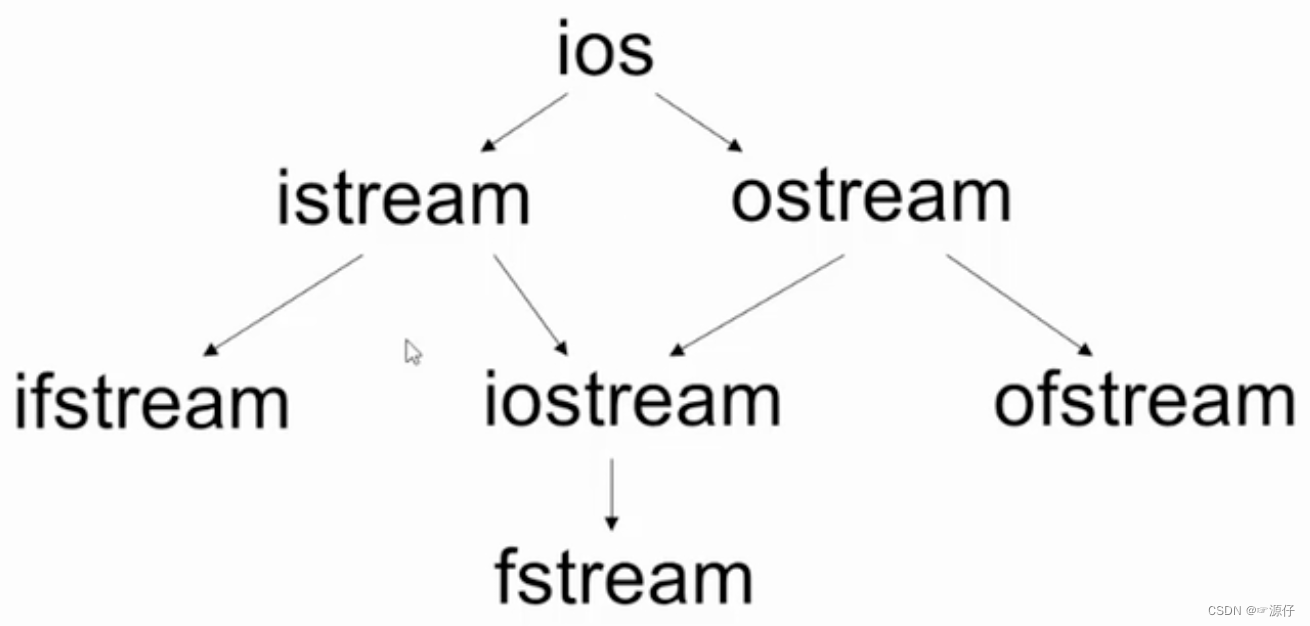


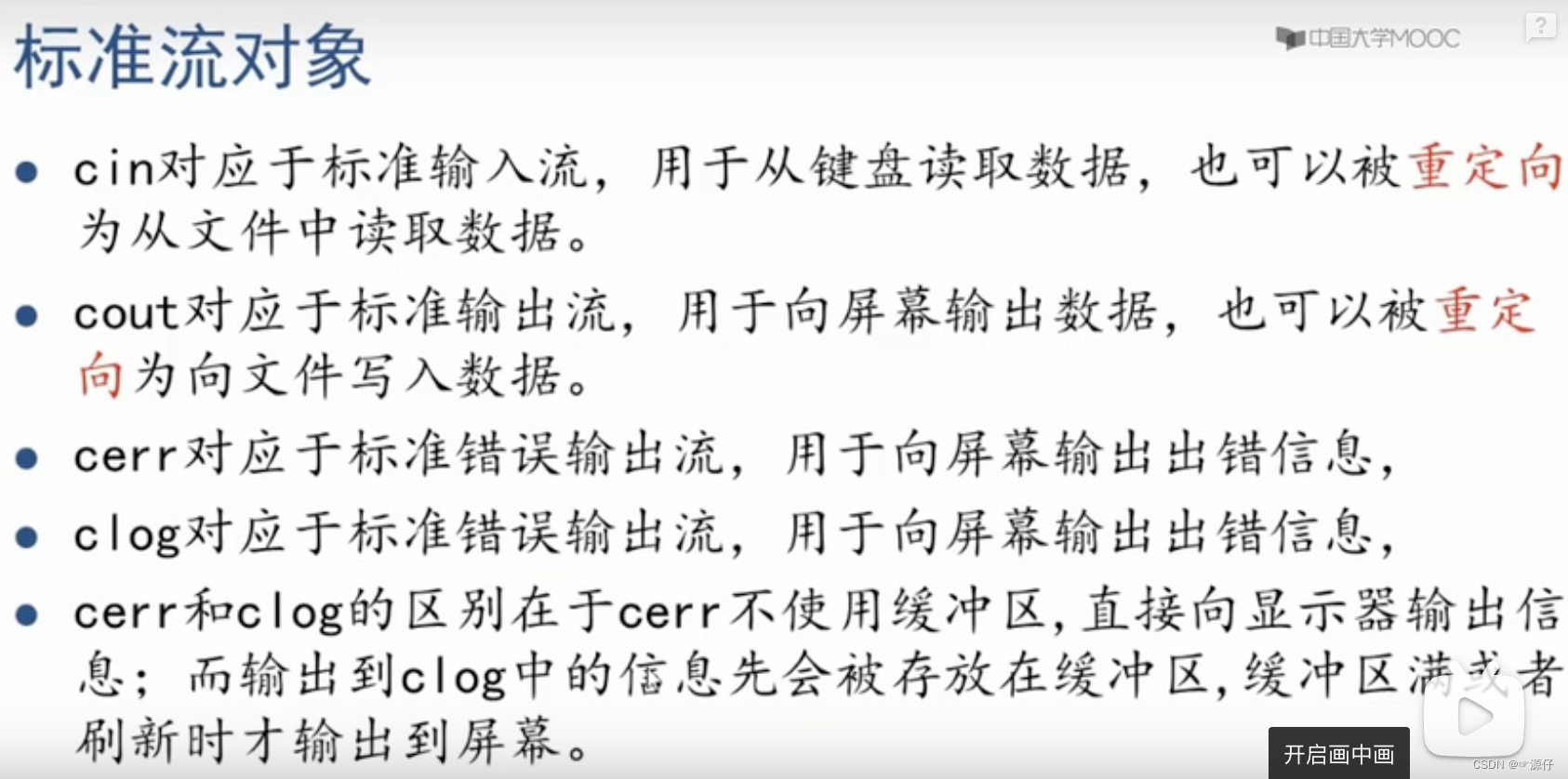
1.1、标准输出重定向
基础知识:在C++中,
stdout代表标准输出流。它是指向标准输出设备的输出流,通常是屏幕或终端。当你使用std::cout进行输出时,实际上是向stdout流中写入数据。类似地,printf()函数也将输出写入到stdout流中。
#include<iostream>
using namespace std;
int main()
{
int x,y;
cin >> x >> y;
freopen("test.txt", "w", stdout); // 将标准输出重定向到test.txt文件
if(y==0) // 除数为0则直接在屏幕/终端上输出错误信息
{
cerr << "error" << endl;
}
else
cout << x/y; // 输出结果到test.txt文件中
return 0;
}
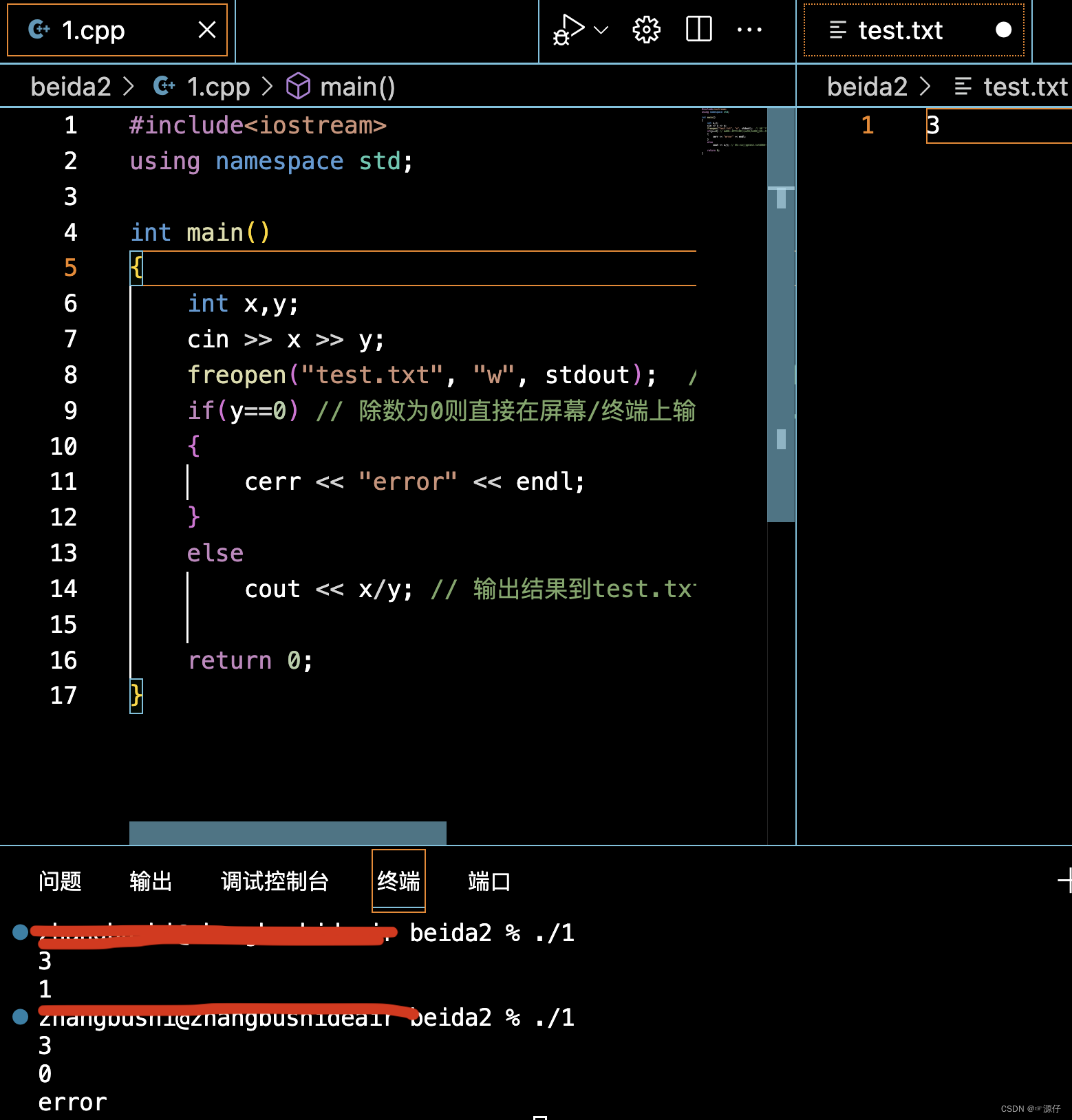
1.2、标准输入重定向
#include<iostream>
using namespace std;
int main()
{
double f; int n;
freopen("test.txt", "r", stdin); //cin 被改为从test.txt中读取数据
cin >> f >> n;
cout << f << "," << n << endl;
return 0;
}
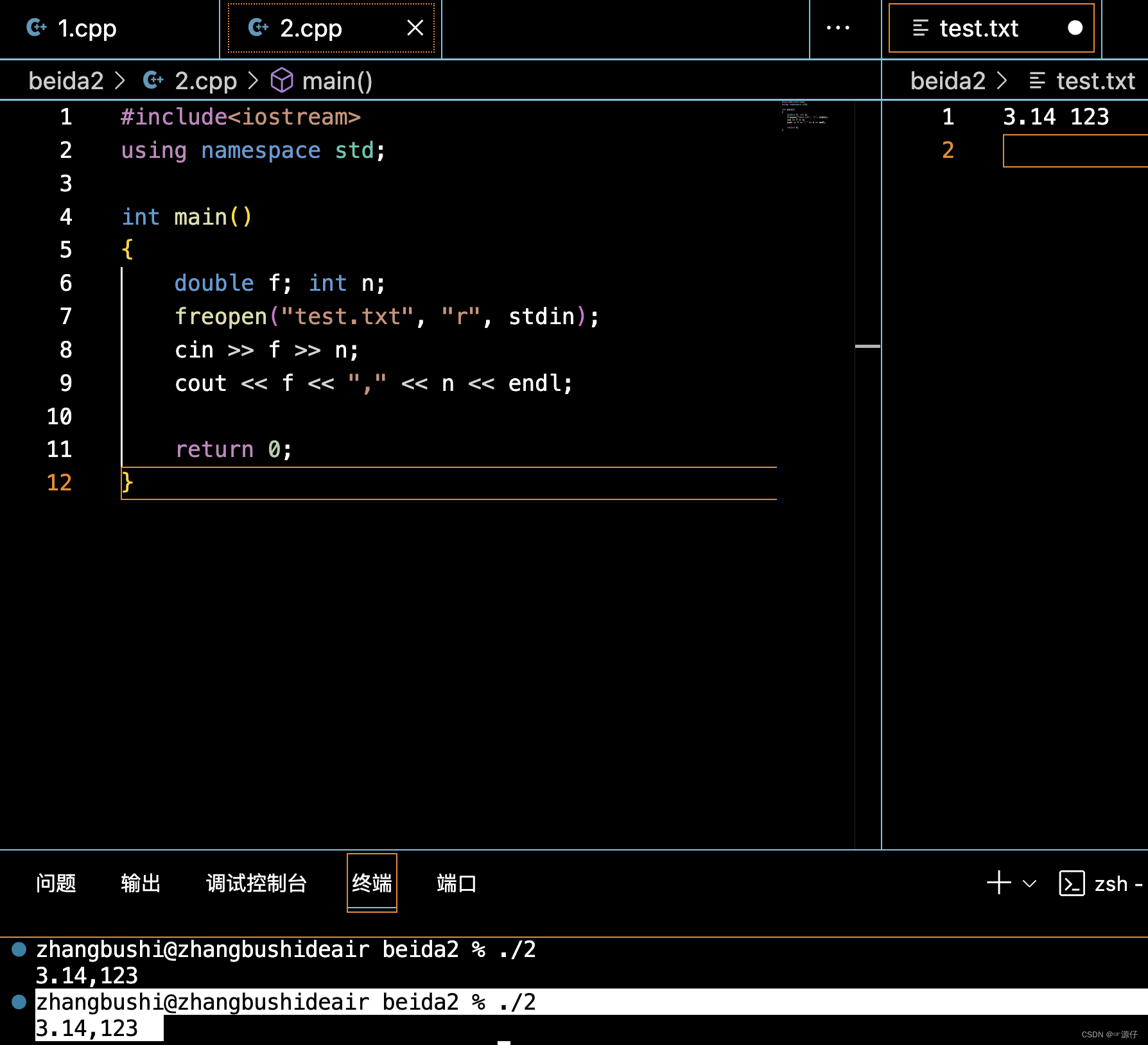
1.3、判断输入流结束
注意事项:
- while(cin>>x):应该是文件中内容输出结束后,cin>>x返回为False,即循环结束。但是我们周到istream的右移运算符的返回值为cin(即* this),,为什么能返回布尔型False呢!
- 这里用到了
强制类型转换符重载(下面做详细解释)。
1.3.1、强制类型转换符重载
在C++中,你可以通过重载类型转换运算符来自定义类对象之间的类型转换。这种转换运算符被称为类型转换函数或转换运算符。以下是几种可以重载的类型转换运算符:
- 1、转换为目标类型的类型转换函数:这种类型的类型转换函数将类对象转换为指定类型。它们的声明形式如下:
operator type() const;
其中type是你想要将类对象转换为的目标类型。这样的重载允许你在使用赋值操作符或传递参数时,隐式地将类对象转换为目标类型。
- 2、转换为布尔类型的类型转换函数:这种类型的类型转换函数将类对象转换为布尔类型,通常用于条件测试。它们的声明形式如下:
explicit operator bool() const;
explicit关键字用于防止隐式转换,确保转换只在需要时发生。
举例来说,假设你有一个名为MyClass的类,你可以重载这些转换运算符以便让MyClass对象能够以期望的方式进行类型转换。下面是一个简单的示例:
#include <iostream>
class MyClass {
int value;
public:
MyClass(int val) : value(val) {}
// 转换为int类型
operator int() const {
return value;
}
// 转换为布尔类型
explicit operator bool() const {
return value != 5; // 输出为:intValue: 5 boolValue: 0
return value != 1; // 输出为:intValue: 5 boolValue: 1
}
};
int main() {
MyClass obj(5);
// 隐式转换为int类型
int intValue = obj;
std::cout << "intValue: " << intValue << std::endl;
// 显式转换为布尔类型
bool boolValue = static_cast<bool>(obj);
std::cout << "boolValue: " << boolValue << std::endl;
return 0;
}
1.4、istream类的成员函数


例:
#include<iostream>
using namespace std;
int main()
{
int x;
char buf[100];
cin >> x;
cin.getline(buf, 90); // 将读取的一行序列存储到buf中
cout << buf << endl;
return 0;
}
OUT:
zhangbushi@zhangbushideair beida2 % ./4
12 abcd
abcd
zhangbushi@zhangbushideair beida2 % ./4
12
zhangbushi@zhangbushideair beida2 %
1.4.1、cin.getline()函数
在C++中,cin.getline()函数从标准输入流中读取字符,并将它们存储到给定的字符数组中,直到达到指定的最大字符数(包括结束符’\0’)或者遇到指定的结束符(默认为换行符’\n’)为止。读取的字符包括结束符之前的所有字符,但不包括结束符本身。如果读取到达了指定的最大字符数,剩余的字符将被丢弃。它的一般形式如下:
istream& getline (char* s, streamsize count, char delim);
其中:
- s是一个指向字符数组的指针,用于存储读取的字符序列。
- count是要读取的最大字符数,包括最后的空字符(‘\0’)。
- delim是可选参数,表示行的结束符,默认为换行符’\n’。
#include <iostream>
int main() {
const int bufferSize = 100;
char buffer[bufferSize];
std::cout << "Enter a line of text: ";
std::cin.getline(buffer, bufferSize);
std::cout << "You entered: " << buffer << std::endl;
return 0;
}
OUT:
beida2 % ./4
Enter a line of text: I love C++.
You entered: I love C++.
2、流操纵算子控制输出格式
- 整数流的基数:流操纵算子dec、oct、hex、setbase
- 浮点数的精度(precision , setprecision)
- 设置域宽(setw,width)
- 用户自定义的流操作纵算字
2.1、流操纵算子dec、oct、hex、setbas
在C++中,流操纵算子dec、oct、hex和setbase用于设置输出整数时的进制格式。它们的作用如下:
dec:将输出的整数视为十进制形式。这是默认的进制格式。
std::cout << std::dec << 123; // 输出 123
oct:将输出的整数视为八进制形式。
std::cout << std::oct << 123; // 输出 173 (八进制)
hex:将输出的整数视为十六进制形式。
std::cout << std::hex << 123; // 输出 7b (十六进制)
setbase:设置输出整数的基数(进制)。它可以接受一个整数参数,表示要使用的进制数。
std::cout << std::setbase(16) << 123; // 输出 7b (十六进制)
这些流操纵算子影响之后的整数输出操作,使得整数以特定的进制格式进行输出。
使用流操纵算子需要:#include<iomainp>

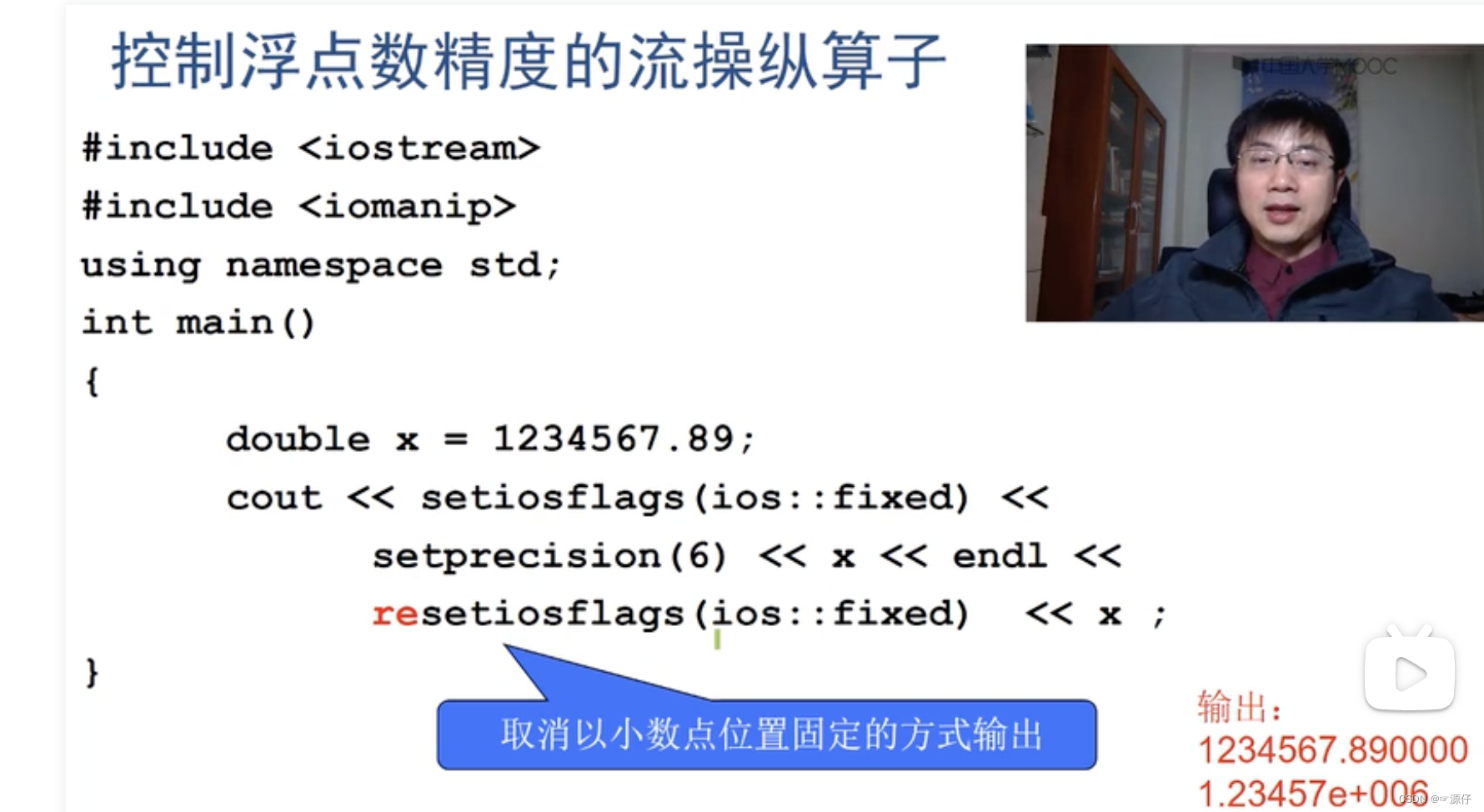
2.2、设置域宽的流操纵算子
- 设置域宽(setw,width)
- 两者功能相同,一个是成员函数,一个是流操作算子,调用方式不同。
cin >> setw(4); 或者cin.width(5)
cout << setw(4); 或者cout.width(5)
在C++中,setw 是 <iomanip> 头文件中定义的一个函数,用于设置输出流中下一个字段的宽度。这个函数的原型如下:
#include <iomanip>
std::setw(int n);
其中,n 是一个整数,表示要设置的字段宽度。
通常,setw 与 std::cout 一起使用,用于格式化输出。例如,你可以使用 setw 来设置输出的字段宽度,以便让输出更加整齐。下面是一个简单的示例:
#include <iostream>
#include <iomanip>
using namespace std;
int main() {
// 方式一
cout << setw(7) << "Hello" << endl;
cout << setw(3) << "World" << endl;
// 方式二
cout.width(7);
cout << "Hello" << endl;
cout.width(2);
cout << "World" << endl;
// 方式三
cout << cout.width(5) << "Hello" << endl;
cout << cout.width(2) << "World" << endl;
return 0;
}
// OUT
beida2 % g++ 5.cpp -o 5
beida2 % ./5
Hello
World
Hello
World
0Hello
0World
beida2 %
在这个示例中,setw(10) 设置了输出字段的宽度为 10 个字符。因此,无论单词是多长,输出都会在 10 个字符的宽度内显示。如果单词长度小于 10,会在单词前补足空格;如果大于 10,会按照单词长度输出。
例二:
#include <iostream>
#include <iomanip>
using namespace std;
int main()
{
int w = 4;
char string[10];
cin.width(5); // 为什么只能读到1234四个字符呢!因为第五个字符默认是/0。
// 宽度设置是一次性的,每次读入和输出之间都要设置宽度
while(cin >> string)
{
cout.width(w++);
cout << string << endl;
cin.width(5);
}
}
//OUT
beida2 % ./6
1234567890
1234
5678
90
例题三:
#include <iostream>
#include <iomanip>
using namespace std;
int main()
{
int n = 141;
double x = 123456.89 , y = 12.34567;
// 1) 分别以十六进制、十进制、八进制先后输出n
cout << "1) " << hex << n << " " << dec << n << " " << oct << n << endl;
// 2) 保留5位有效数字
cout << "2) " << setprecision(5) << x << " " << y << " " << endl;
// 3) 保留小数点后5位
cout << "3) " << fixed << setprecision(5) << x << " " << y << endl;
// 4) 科学技术法输出,且保留小数点后面5位
cout << "4) " << scientific << setprecision(5) << x << " " << y << endl;
// 5) 非负数要显示正号,输出宽度为12字符,宽度不足则用'*'填充
cout << "5) " << showpos << fixed << setw(12) << setfill('*') << 12.1 << endl;
// 6) 非负数不显示正号,输出宽度为12字符,宽度不足则右边用填充字符填充
cout << "6) " << noshowpos << setw(12) << left << 12.1 << endl; // left:左对齐
// 7) 输出宽度为12字符,宽度不足则左边用填充字符填充
cout << "7) " << setw(12) << right << 12.1 << endl;
// 8) 宽度不足时,负号和数值分列左右,中间用填充字符填充
cout << "8) " << setw(12) << internal << -12.1 << endl;
cout << "9) " << 12.1 << endl;
}
// OUT
1) 8d 141 215
2) 1.2346e+05 12.346
3) 123456.89000 12.34567
4) 1.23457e+05 1.23457e+01
5) ***+12.10000
6) 12.10000****
7) ****12.10000
8) -***12.10000
9) 12.10000
2.3、用户自定义流操作算子
ostream $tab(ostream &output)
{
return output << '\t';
}
cout << "aa" << tab << "bb" << endl; // aa和bb之间相隔一个制表符输出
输出:aa bb
上面为何能这样输出呢!
因为iostream里对 << 进行了重载(成员函数)
ostream & operator<<(ostream & (*p)(ostream &));
该函数内部会调用p所指向的函数,且以*this作为参数。hex、dex、oct函数。
3、文件读写
3.1、文件和流
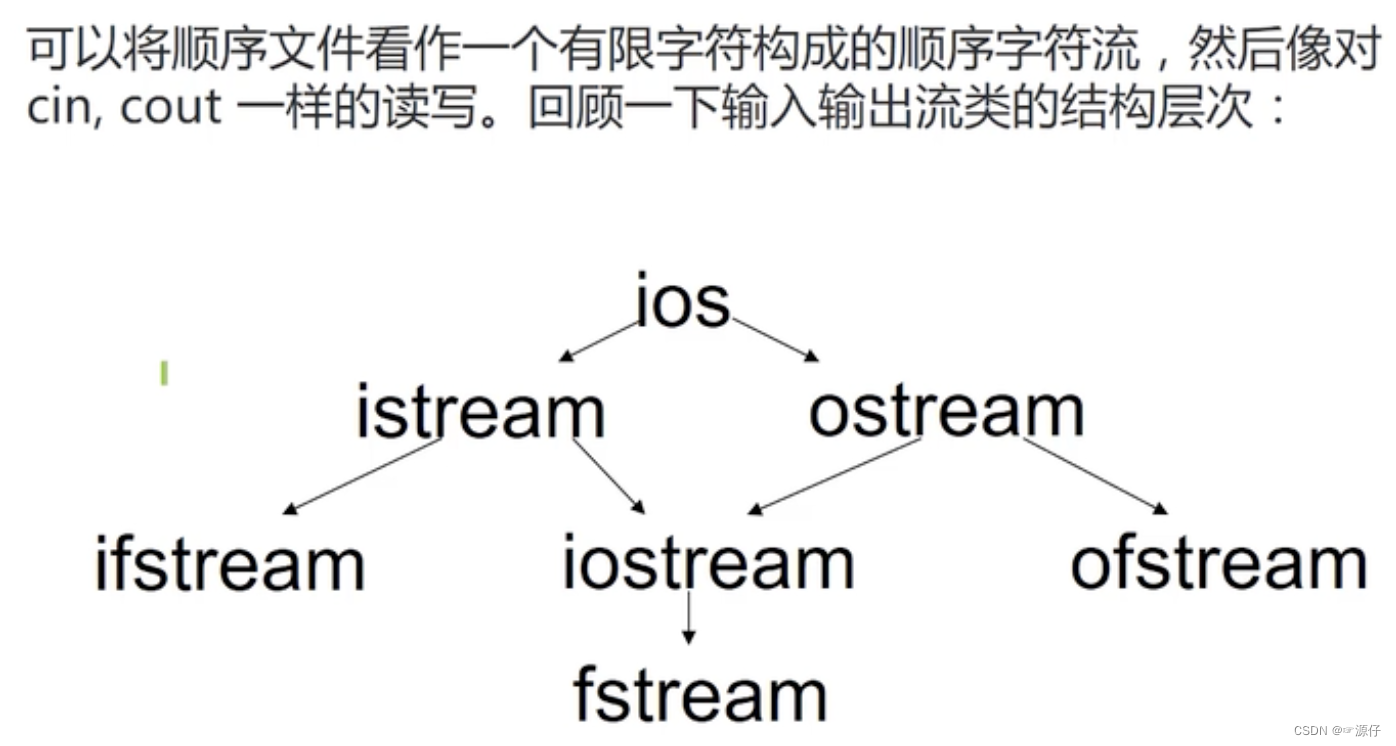
在C++中,这些类都是用于文件输入输出的类。它们分别具有以下作用:
-
ifstream: 这个类用于从文件中读取数据。ifstream类派生自istream,因此可以使用输入运算符 (>>) 和其他与输入相关的方法来从文件中读取数据。 -
iostream: 这个类可以用于同时进行输入和输出操作,但通常它用于控制台输入输出。iostream类派生自istream和ostream,所以它继承了输入和输出的功能。 -
ofstream: 这个类用于向文件中写入数据。ofstream类派生自ostream,因此可以使用输出运算符 (<<) 和其他与输出相关的方法来向文件中写入数据。 -
fstream: 这个类可以用于同时进行文件输入和输出操作,即读写文件。fstream类同时派生自ifstream和ofstream,因此可以实现文件的读写操作。
这些类提供了方便的方法来处理文件输入输出,在C++中常用于文件的读取、写入以及读写组合操作。
3.2、创建文件
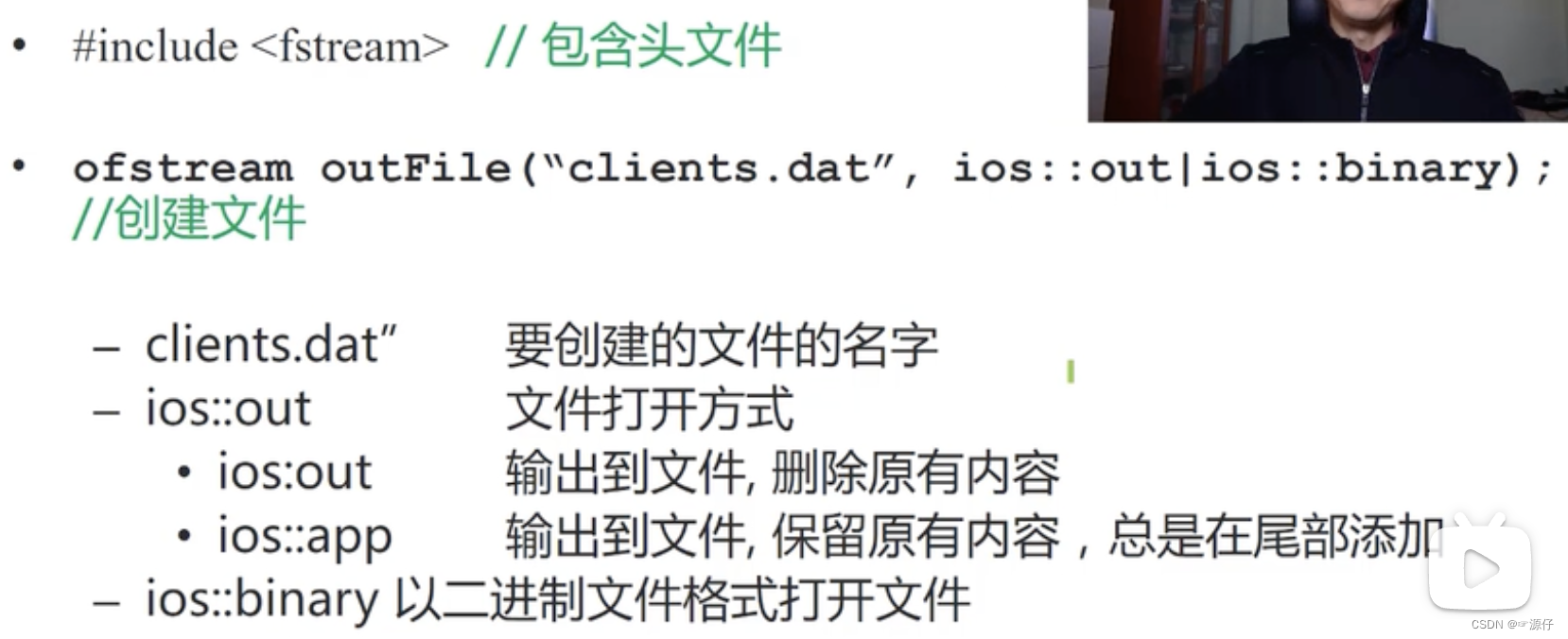

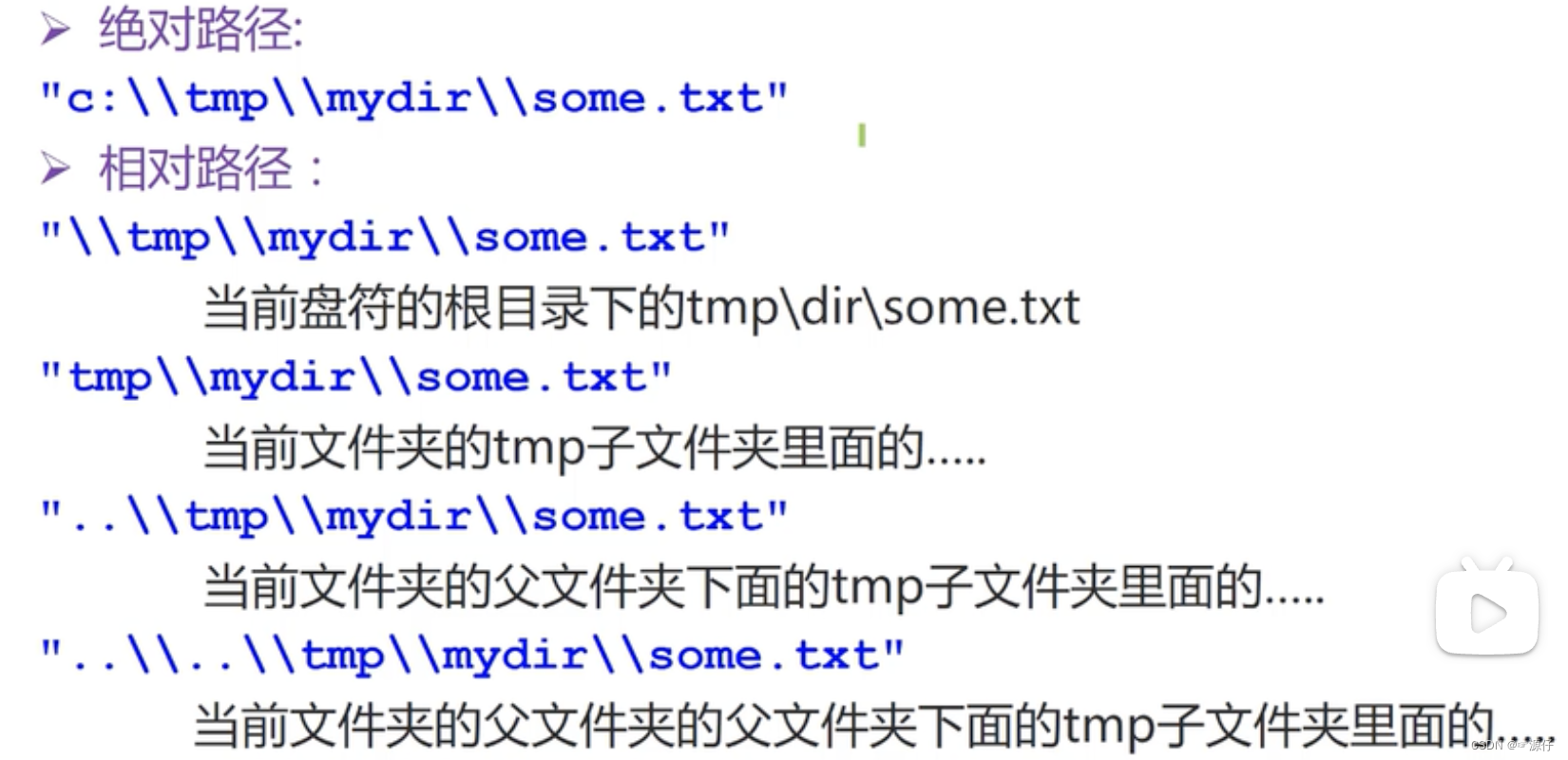
3.3、文件的读写

3.4、文件的读写指针

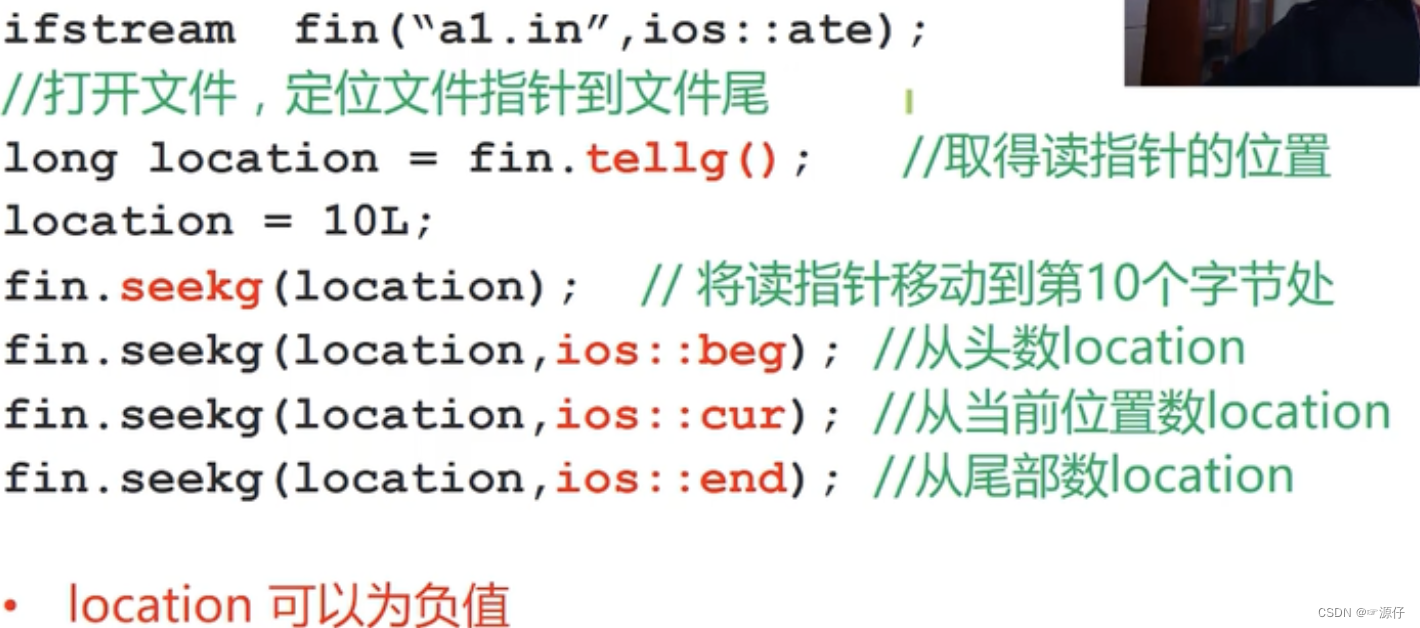
3.4、字符文件读写
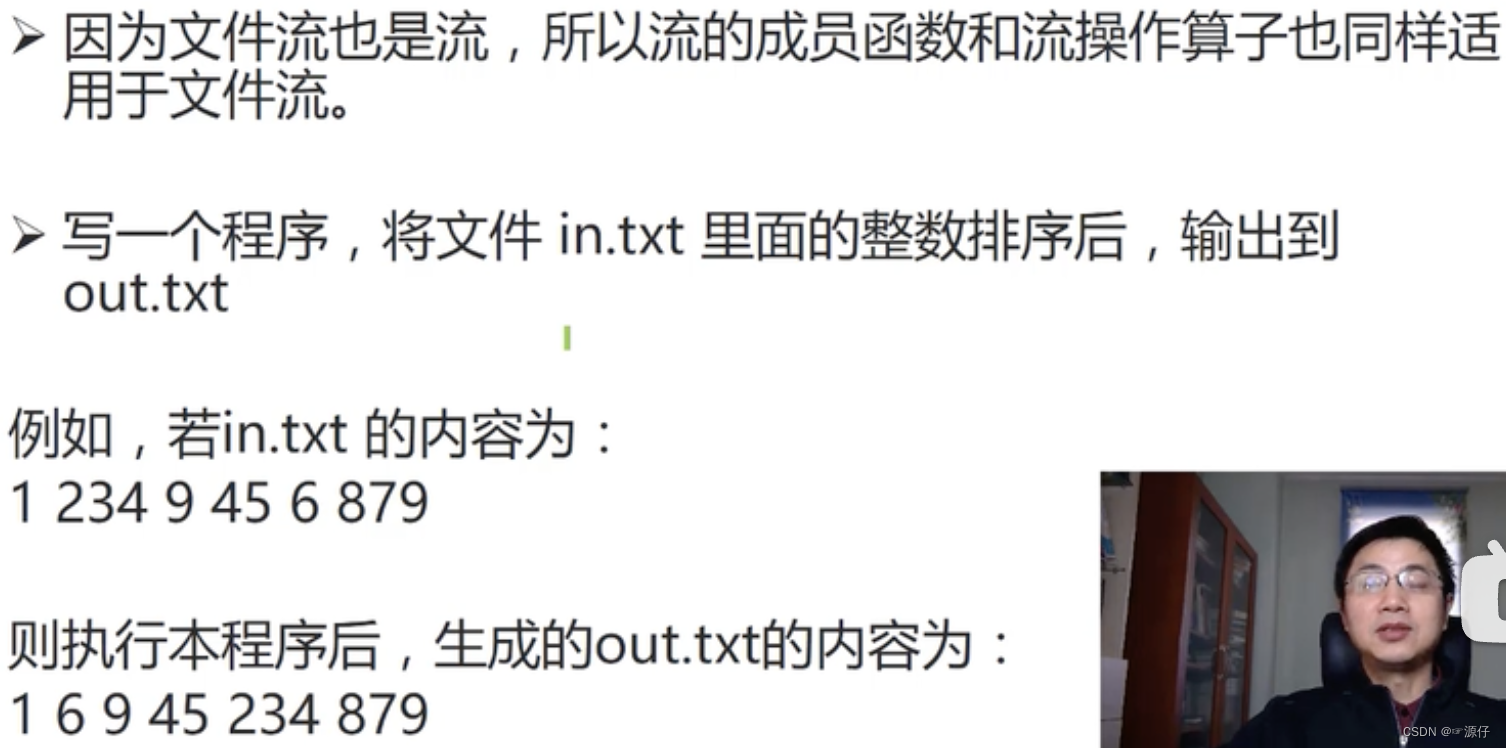
#include<iostream>
#include<fstream>
#include<vector>
#include<algorithm>
using namespace std;
int main()
{
vector<int> v;
ifstream srcFile("in.txt", ios::in); // 打开文件,并对文件进行读取;采用ios::in方式打开文件
ofstream destFile("out.txt", ios::out); // 打开文件,并进行写入,用ios::out
int x;
while(srcFile >> x) // srcFile内容输入到x;
{
v.push_back(x);
}
sort(v.begin(), v.end());
for (int i=0; i < v.size(); i++)
{
destFile << v[i] << " "; // 表示v[i]输出到destFile
}
// 打开的文件必须要关闭;
// 1、文件是在硬盘上的:而硬盘的访问速度要比内存慢很多的。
// 要往文件写入数据时候,需要先把内存填满,再访问硬盘,把数据整体写入硬盘文件中。如果不关闭文件,
// 可能数据还在内存中,导致文件中的数据缺失等问题。
// 2、在许多操作系统中,一个应用程序所打开的文件数目是有上限的,如果不停的打开文件忘了关的话,
// 超过上限,这个程序就会打不开任何文件了;
destFile.close();
srcFile.close();
return 0;
}
注意事项:打开的文件必须要关闭:
- 1、文件是在硬盘上的:而硬盘的访问速度要比内存慢很多的。要往文件写入数据时候,需要先把内存填满,再访问硬盘,把数据整体写入硬盘文件中。如果不关闭文件,可能数据还在内存中,导致文件中的数据缺失等问题。(尽量减少访问硬盘的次数)。
- 2、在许多操作系统中,一个应用程序所打开的文件数目是有上限的,如果不停的打开文件忘了关的话,超过上限,这个程序就会打不开任何文件了;
3.5、二进制文件读写(非常重要)

例题1:二进制文件的写入与读取
#include<iostream>
#include<fstream>
using namespace std;
int main()
{
// ofstream创建some.dat二进制文件,并以写ios::out和二进制方式打开
ofstream fout("some.dat", ios::out | ios::binary);
int x = 120;
// write的第一个参数:const char *,x为int,所以用了强制类型转化
// write的第二个参数:表示写入数据内存的大小,这里是4个字节
fout.write((const char *)(&x), sizeof(int));
fout.close();
// 以读ios::in和二进制方式打开
ifstream fin("some.dat", ios::in | ios::binary);
int y;
// read第一个参数类型为char *指针
fin.read((char *) &y, sizeof(int));
fin.close();
cout << y << endl;
return 0;
}
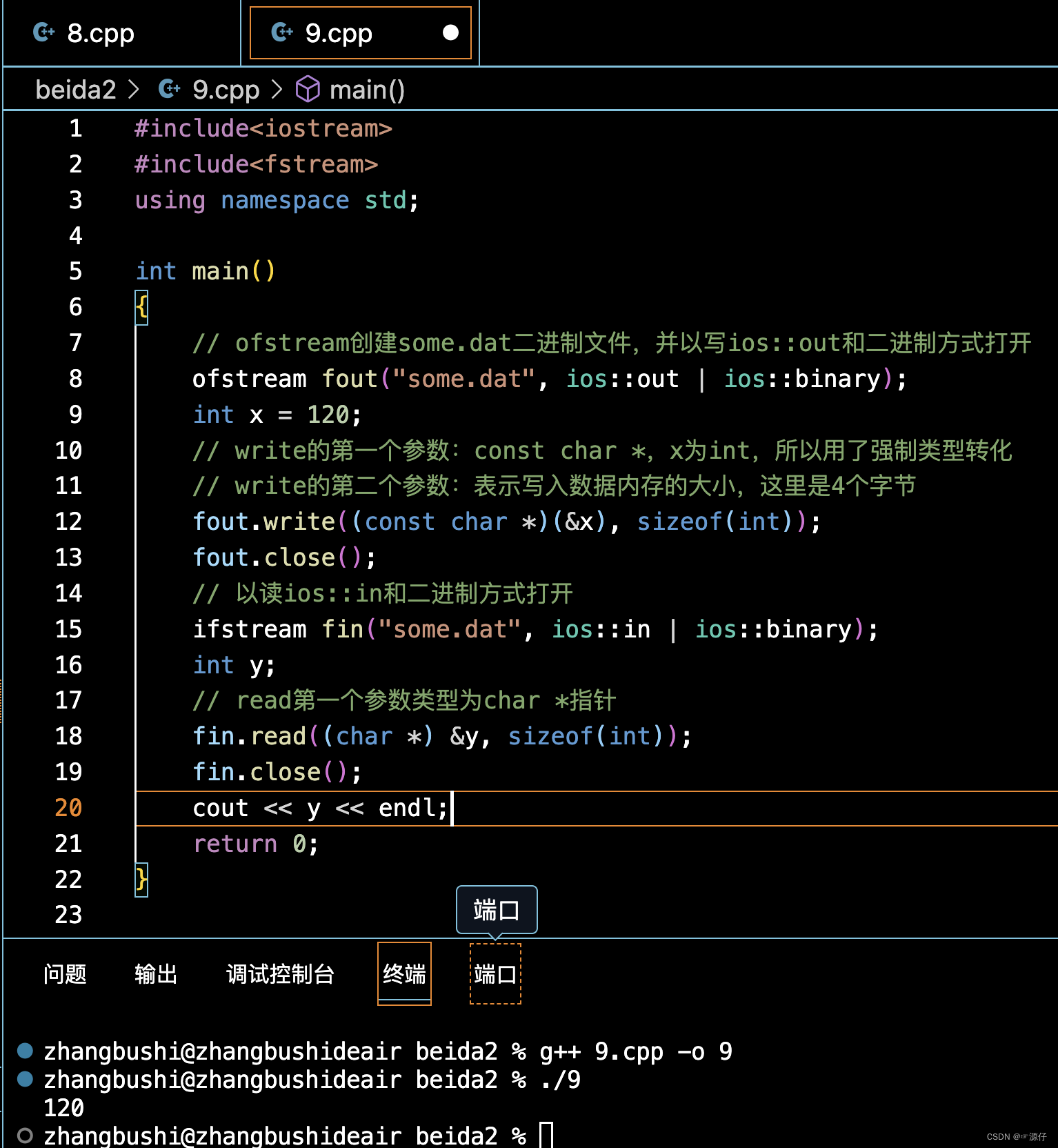
例题2:文件的写入
从键盘输入几个学生的姓名的成绩,并以二进制文件形式保存。
#include<iostream>
#include<fstream>
using namespace std;
struct Student
{
char name[20];
int score;
};
int main()
{
Student s;
ofstream OutFile("student.dat", ios::out | ios::binary);
while(cin >> s.name >> s.score)
{
OutFile.write((char *) & s, sizeof(s));
}
OutFile.close();
return 0;
}
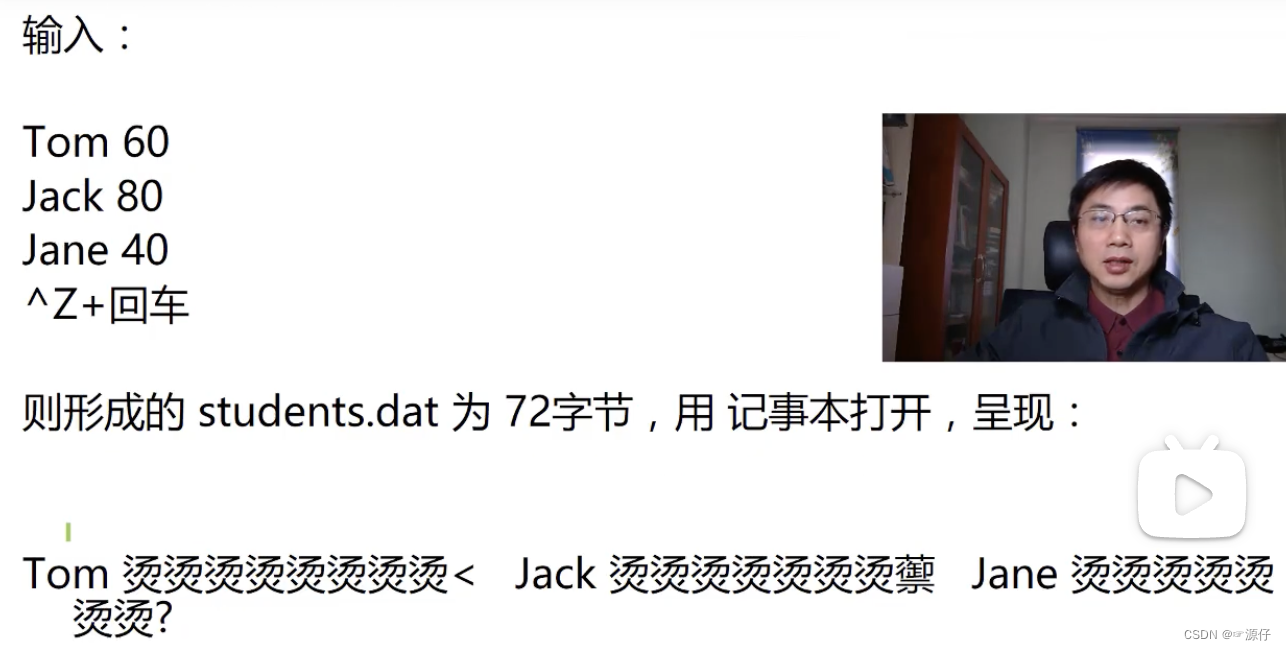
例题3:二进制文件的写入
C 库函数 int strncmp(const char *str1, const char *str2, size_t n) 把 str1 和 str2 进行比较,最多比较前 n 个字符。
// 声明
int strncmp(const char *str1, const char *str2, size_t n)
参数
- str1 – 要进行比较的第一个字符串。
- str2 – 要进行比较的第二个字符串。
- n – 要比较的最大字符数。
返回值:
- 如果返回值 < 0,则表示 str1 小于 str2。
- 如果返回值 > 0,则表示 str1 大于 str2。
- 如果返回值 = 0,则表示 str1 等于 str2。
#include<iostream>
#include<fstream>
using namespace std;
struct Student
{
char name[20];
char end[20];
int score;
};
int main()
{
Student s;
ofstream OutFile("student.dat", ios::out | ios::binary);
int i = 0;
int over;
while(cin >> s.name >> s.score >> s.end)
{
OutFile.write((char *) & s, sizeof(s));
over = strncmp(s.name, s.end, 4);
if (over == 0)
{
break;
}
}
OutFile.close();
return 0;
}
输出结果:(首先会生成一个二进制student.dat文件)
beida2 % ./10
Tom 10 end
ZBS 27 end
end 0 end
beida2 %
例题4:二进制文件内容的读取
#include<iostream>
#include<fstream>
using namespace std;
struct Student
{
char name[20];
char end[20];
int score;
};
int main()
{
Student s;
ifstream inFile("student.dat", ios::out | ios::binary);
// 查看文件是否打开重开
if(!inFile)
{
cout << "error" << endl;
return 0;
}
// 将文件内容读取到s这个地址上,
while(inFile.read((char* ) & s, sizeof(s)))
{
int readedBytes = inFile.gcount(); // 看看刚才读取了多少字节
cout << s.name << " " << s.score << " " << s.end << endl;
cout << "readedBytes = " << readedBytes << endl;
}
inFile.close();
return 0;
}
OUT:
beida2 % ./11
Tom 10 end
readedBytes = 44
zbs 27 end
readedBytes = 44
end 0 end
readedBytes = 44
beida2 %
例题5:二进制文件内容的读写:并更改内容
student.dat文件内容如下:
Tom 10 end
zbs 27 end
end 0 end
#include<iostream>
#include<fstream>
using namespace std;
struct Student
{
char name[20];
char end[20];
int score;
};
int main()
{
Student s;
fstream iofile("student.dat", ios::in | ios::out | ios::binary);
if(!iofile)
{
cout << "error" << endl;
return 0;
}
iofile.seekp(sizeof(s), ios::beg); // 定位写指针到第2个记录
iofile.write("Mike", strlen("Mike")+1); // +1是表示把结尾的\0也写入
iofile.seekg(0, ios::beg); // 定位读指针到开头
while(iofile.read((char*) & s, sizeof(s)))
{
cout << s.name << " " << s.score << " " << s.end << endl;
}
iofile.close();
return 0;
}
输出:
Tom 10 end
Mike 27 end (这里ZBS变成了Mike)
end 0 end
例题5:二进制文件内容的读写:并更改内容
#include<iostream>
#include<fstream>
using namespace std;
/*
用法示例:./13 src.dat dest.dat
即将src.dat拷贝到dest.dat
如果dest.dat原来就有,则原来的文件会被覆盖
*/
// argc:命令行参数的个数;argv:命令行参数;
int main(int argc, char * argv[])
{
if(argc != 3)
{
cout << "File name missing!" << endl;
return 0;
}
ifstream inFile(argv[1], ios::binary | ios::in); // 打开文件用于读取
if (!inFile)
{
cout << "Source file open error." << endl;
return 0;
}
ofstream outFile(argv[2], ios::binary | ios::out); // 打开文件用于写
if(!outFile)
{
cout << "New file open error." << endl;
inFile.close(); // 打开的文件一定要关闭
return 0;
}
char c;
while(inFile.get(c)) // 每次读取一个字符
{
outFile.put(c); // 每次写入一个字符
}
outFile.close();
inFile.close();
return 0;
}











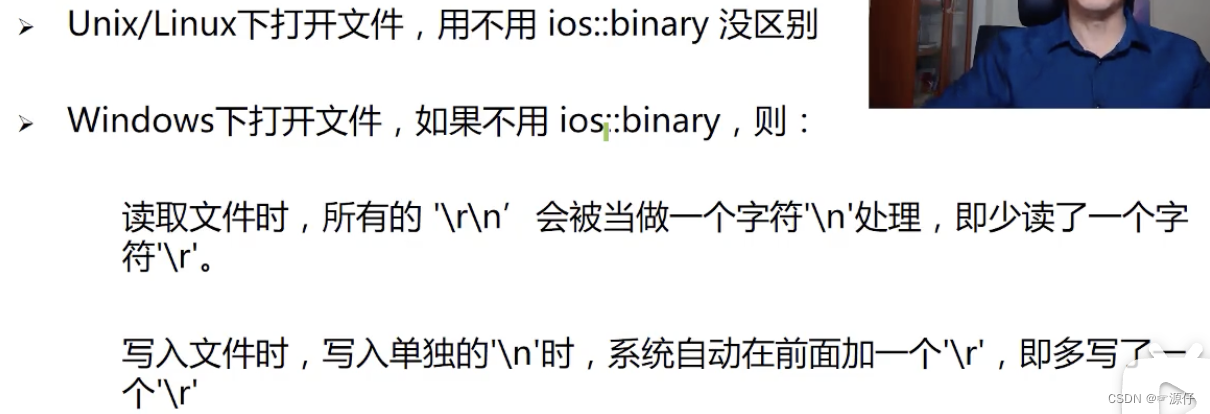















 254
254











 被折叠的 条评论
为什么被折叠?
被折叠的 条评论
为什么被折叠?










